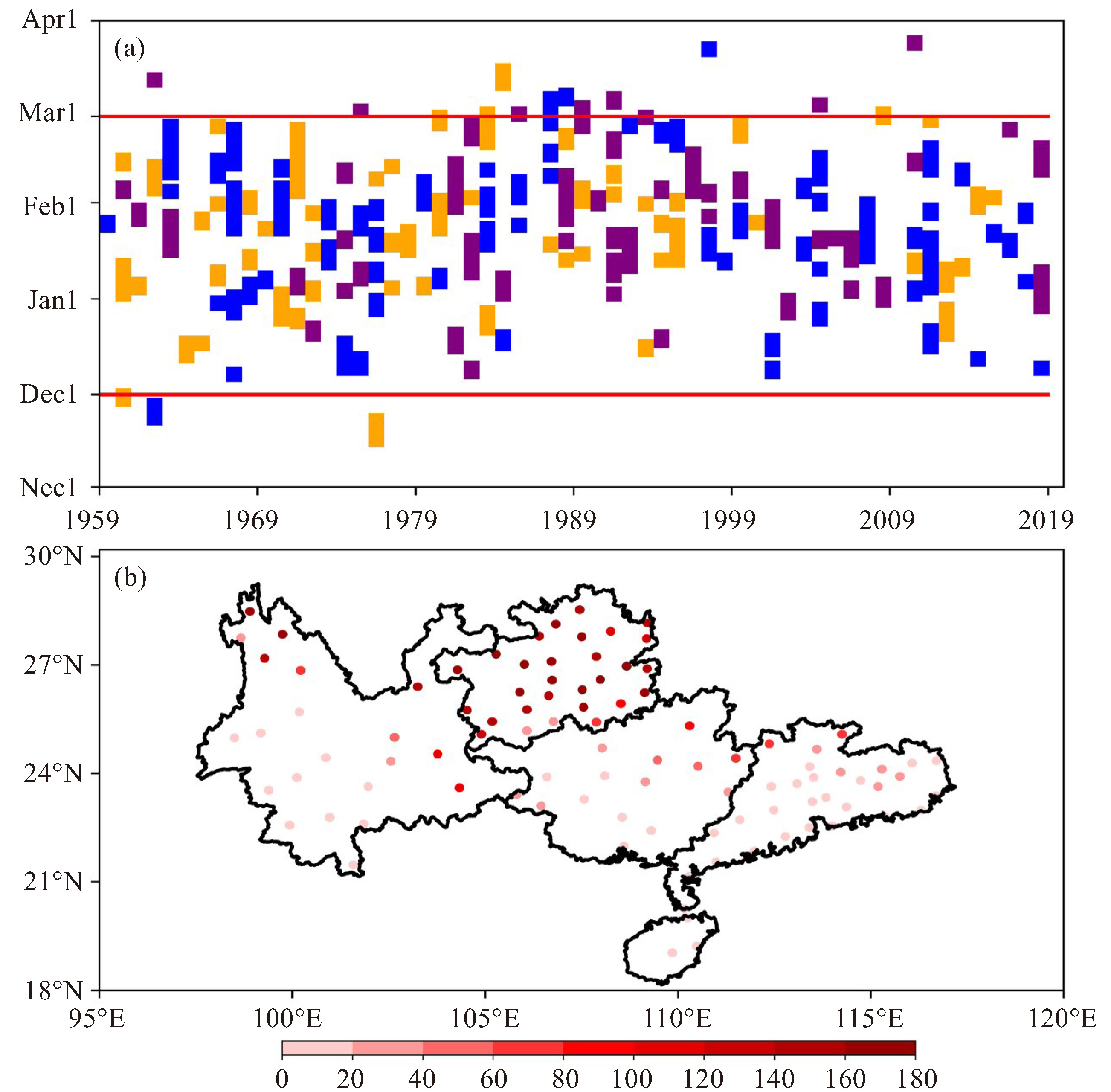Circulation Characteristics and Drivers of Persistent Cold Rain and Snow Events in Southern China
-
摘要: 利用常规观测资料和NCEP再分析资料,定义并识别了1960—2019年南方地区持续性低温雨雪天气过程。结果表明,欧亚中高纬大型槽脊系统是南方持续性低温雨雪过程的关键环流特征,包括单阻横槽型、两槽一脊型和平直环流型三种类型,前两者分别在乌拉尔山区域、贝加尔湖附近有阻塞高压或高压脊。其中单阻横槽型高空槽脊最强,冷空气路径偏西,低层冷高压最强,导致南方低温雨雪期间平均气温最低,持续时间最长、影响范围最大。这些稳定的高空槽脊形势,伴随地面强冷空气和暖湿水汽输送,共同影响造成南方持续性低温雨雪天气过程。通过相关性分析,发现500 hPa极涡、欧亚中高纬度的高压脊、高原槽,地面西伯利亚高压,以及赤道中东太平洋海温是影响南方冬季持续性低温雨雪天气年际变化的关键区域和关键因子。Abstract: Based on conventional observational data and NCEP reanalysis data, this study defines and identifies persistent cold rain and snow events (PCRSEs) in southern China during 1960-2019. The results show that the large-scale trough-ridge systems in mid-to-high-latitude Eurasia are the key circulation features of these events, which can be categorized into three types: the single blocking transverse trough, two-trough-one-ridge, and zonal circulation. The first two types are characterized by blocking highs or ridges near the Ural Mountains or Lake Baikal, respectively. Among them, the single blocking transverse trough type exhibits the strongest upper-tropospheric trough-ridge structure, a westward-displaced cold air pathway, and the most intense surface cold high, leading to the lowest average temperatures, longest durations, and widest impact areas observed during PCRSEs in southern China. These stable uppertropospheric trough-ridge patterns, combined with strong surface cold air advection and warm-moist water vapor transport, collectively drive PCRSE occurrence in southern China. Correlation analysis reveals that the 500 hPa polar vortex, mid-to-high-latitude Eurasian ridges, Tibetan Plateau troughs, the Siberian High, and equatorial central-eastern Pacific sea surface temperature anomalies are key drivers of the interannual variability of winter PCRSEs in southern China.
-
表 1 南方冬季持续性低温雨雪事件的年代际变化(12—2月)
年代 1960s 1970s 1980s 1990s 2000s 2010s 频次 26.5 30.5 27.5 27.5 17.5 24 年平均影响日数/d 23.1 26.1 24.9 22.3 15.4 22.3 平均气温/℃ 1.1 1.3 1.3 1.4 1.3 1.4 平均降水强度/(mm·d-1) 1.6 1.3 1.6 2.0 1.8 1.5 表 2 各类南方持续性低温雨雪事件的主要特征
类型 总影响日数/d 平均影响日数/d 累计影响范围/(106 km2) 平均影响范围/(105 km2) 平均气温/℃ P1 568 8.9 24.4 3.8 1.2 P2 417 8.7 15.7 3.3 1.6 P3 435 7.8 19.5 3.5 1.5 -
[1] 黄子芹, 阳薇, 赖英度. 2008年资源县罕见雨雪冰冻灾害及防御对策初探[J]. 气象研究与应用, 2008, 29(S2): 22-24. [2] 黄珍珠, 杜尧东, 潘蔚娟, 等. 2008年广东罕见寒冷灾害的特点、影响及防寒减灾对策[J]. 广东气象, 2008, 30(1): 8-11. [3] 徐雅雯, 吴可可, 朱丽蓉, 等. 中国南方雨雪冰冻灾害受损森林植被研究进展[J]. 生态环境学报, 2010, 26(6): 1 485-1 494. [4] 丁一汇, 王遵娅, 宋亚芳, 等. 中国南方2008年1月罕见低温雨雪冰冻灾害发生的原因及其与气候变暖的关系[J]. 气象学报, 2008, 66 (5): 808-825. [5] 吴乃庚, 林良勋, 李天然, 等. 2008年初广东罕见低温雨雪冰冻天气的成因初探[J]. 广东气象, 2008, 30(1): 4-7. [6] 李艳玉, 王艳兰, 蒋冬雁, 等. 2008年初桂林低温雨雪冰冻灾害天气特征及预报技术分析[J]. 气象研究与应用, 2009, 30(S2): 50-52. [7] 李崇银, 杨辉, 顾薇. 中国南方雨雪冰冻异常天气原因的分析[J]. 气候与环境研究, 2008, 13(2): 113-122. [8] 陶诗言, 卫捷. 2008年1月我国南方严重冰雪灾害过程分析[J]. 气候与环境研究, 2008, 13(4): 337-350. [9] 王东海, 柳崇健, 刘英, 等. 2008年1月中国南方低温雨雪冰冻天气特征及其天气动力学成因的初步分析[J]. 气象学报, 2008, 66(3): 405-422. [10] 杨贵明, 孔期, 毛冬艳, 等. 2008年初"低温雨雪冰冻" 灾害天气的持续性原因分析[J]. 气象学报, 2008, 66(5): 837-850. [11] 高安宁, 陈见, 李生艳, 等. 2008年华南西部罕见低温冷害天气成因分析[J]. 热带气象学报, 2009, 25(1): 110-116. [12] 张春艳, 张耀存. 2008年初持续性低温雨雪冰冻事件的东亚高空急流特征[J]. 热带气象学报, 2013, 29(2): 306-314. [13] 姚蓉, 许霖, 张海, 等. 湖南2008/2011年两次低温雨雪冰冻灾害成因与影响对比分析[J]. 灾害学, 2012, 27(4): 75-79. [14] 钱维宏, 张宗婕. 南方持续低温冻雨事件预测的前期信号[J]. 地球物理学报, 2012, 55(5): 1 501-1 512. [15] 李灿, 张端禹, 冯明, 等. 南方极端低温雨雪冰冻过程天气学特征分析[J]. 暴雨灾害, 2009, 28(4): 321-327. [16] 覃志年, 钟利华, 刘莉红, 等. 2008年初广西异常低温雨雪冰冻天气影响因子分析[J]. 气象, 2010, 36(10): 14-20. [17] 朱秋宇, 何慧, 周秀华, 等. 广西持续性低温雨雪冰冻过程特征和气候成因分析[J]. 气象研究与应用, 2019, 40(1): 38-41. [18] 陆虹, 周秀华, 黄卓, 等. 华南地区低温雨雪事件的时空变化特征[J]. 生态学杂志, 2019, 38(1): 237-246. [19] 宗海锋, 布和朝鲁, 彭京备, 等. 中国南方大范围持续性低温、雨雪和冰冻组合性灾害事件: 客观识别方法及关键特征[J]. 大气科学, 2022, 46(5): 1 055-1 070. [20] ZHANG H, QIN J, LI Y. Climatic background of cold and wet winter in southern China: Part I. Observational analysis[J]. Climate Dyn, 2011, 37(11-12): 2 335-2 354. [21] ZHANG Z, QIAN W. Identifying regional prolonged low temperature events in China[J]. Adv Atmos Sci, 2011, 28(2): 338-351. [22] QIAN X, MIAO Q, ZHAI P, et al. Cold-wet spells in mainland China during 1951-2011[J]. Nat Hazards, 2014, 74(2): 931-946. [23] 唐熠, 周秀华, 郑传新, 等. 广西重大低温雨雪冰冻过程500hPa信号场异常特征分析[J]. 气象, 2019, 45(10): 1 446-1 456. [24] 廖圳. 中国南方持续性低温雨雪冰冻事件环流分型特征[D]. 北京: 中国气象科学研究院. [25] 王艳兰, 伍静, 唐桥义, 等. 广西长低温雨雪冰冻过程环流特征及低温扰动分析[J]. 气象科技, 2022, 50(1): 75-84. [26] 布和朝鲁, 纪立人, 施宁. 2008年初我国南方雨雪低温天气的中期过程分析. Ⅰ: 亚非副热带急流低频波[J]. 气候与环境研究, 2008, 13 (4): 419-433. [27] 朱艳峰. 一个适用于描述中国大陆冬季气温变化的东亚冬季风指数[J]. 气象学报, 2008, 66(5): 781-788. -






 下载:
下载:











 粤公网安备 4401069904700003号
粤公网安备 4401069904700003号